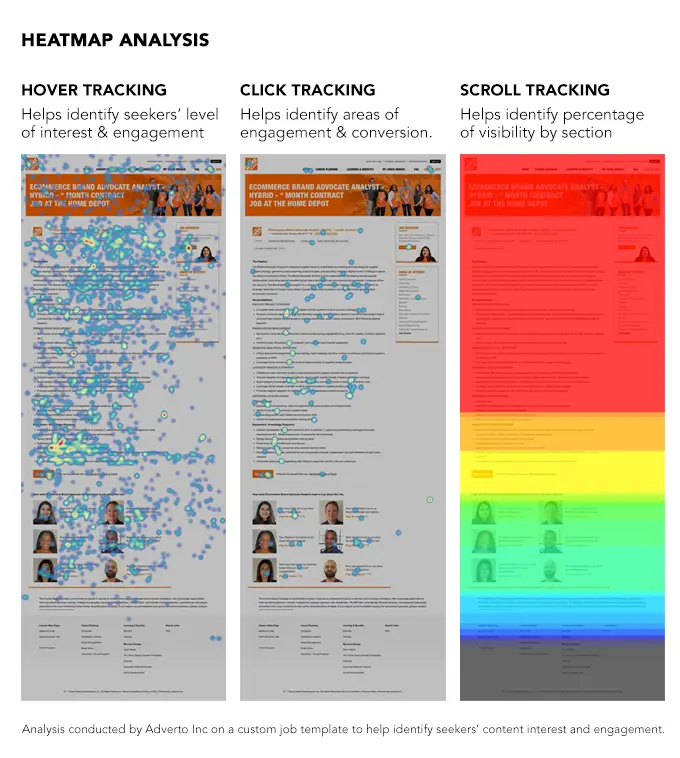Using Heatmaps to Improve Candidate Experience on Your Career Site
In today's competitive job market, it's crucial for employers to provide an exceptional candidate experience on their career sites. One powerful tool that can help you understand candidate behavior and optimize the user experience is heatmaps. By analyzing heatmaps, you can gain valuable insights into how candidates engage with your career site, identify areas for improvement, and ultimately attract and retain top talent. In this blog post, we will explore the concept of heatmaps, discuss the different types of career site heatmaps, highlight the importance of analyzing candidate experience, and provide a comprehensive list of ten key elements to monitor on your career site using heatmaps.
What are heatmaps and the types of career site heatmaps:
To begin, let's define what heatmaps are and how they function. Heatmaps visually represent user engagement by using color-coded overlays to indicate the areas on a webpage where users interact the most. This data is collected based on various user actions such as clicks, hovers, and scrolls. The three main types of heatmaps used on career sites are:
Click heatmaps:
Click heatmaps display the areas on your career site that receive the most clicks. By analyzing click patterns, you can determine which elements, such as job listings, call-to-action buttons, or navigation menus, attract the most attention from candidates.
Hover heatmaps:
Hover heatmaps show the areas where users hover their mouse cursor the most. This type of heatmap can reveal which sections or elements on your career site generate curiosity or interest, even if they are not clicked. It provides insights into user attention and engagement.
Scroll heatmaps:
Scroll heatmaps depict how far down the page candidates scroll before leaving or engaging further. These heatmaps can help you understand if candidates are reaching the most important content, such as job details or application forms, or if they are dropping off before exploring all the relevant information.

Understanding the different types of heatmaps and their unique insights allows you to comprehensively analyze candidate behavior on your career site.
Importance of analyzing candidate experience with heatmaps:
Creating a positive candidate experience is essential for attracting top talent. Candidates who have a seamless and engaging experience on your career site are more likely to apply for your job opportunities and view your company in a positive light. By utilizing heatmaps, you can gather crucial data on candidate behavior, preferences, and pain points. Here are some key reasons why analyzing candidate experience with heatmaps is crucial:
Identify engagement hotspots:
Heatmaps enable you to identify the areas of your career site that receive the highest engagement. By understanding these hotspots, you can optimize your content placement, ensure important information is easily accessible, and highlight the most attractive job opportunities.
Improve user flow:
Heatmaps provide insights into how candidates navigate through your career site. By identifying bottlenecks or areas where candidates drop off, you can streamline the user flow, remove any obstacles, and guide candidates towards desired actions, such as submitting applications or exploring more job listings.
Optimize content and design:
Heatmaps help you evaluate the effectiveness of your content and design elements. You can determine if your call-to-action buttons are placed strategically, if your job descriptions are engaging, or if your application forms are user-friendly. By making data-driven optimizations, you can enhance the overall user experience and increase conversions.
Enhance mobile responsiveness:
With the increasing use of mobile devices, it's crucial to ensure your career site is optimized for mobile users. Heatmaps can reveal how candidates interact with your site on different devices, allowing you to identify any usability issues and make necessary adjustments to improve mobile responsiveness.
Validate design decisions:
If you're considering design changes or implementing new features on your career site, heatmaps can serve as a valuable validation tool. By running A/B tests and analyzing heatmaps, you can make informed decisions based on real user data, ensuring that the changes align with candidate preferences and expectations.
10 things to monitor on a career site with heatmaps:
Now that we understand the significance of analyzing candidate experience with heatmaps, let's delve into the ten key elements you should monitor on your career site using heatmaps. By keeping a close eye on these elements, you can identify areas for improvement, enhance the candidate experience, and optimize the performance of your career site:
Call-to-action buttons:
Analyze which CTAs attract the most clicks and optimize their placement for better conversions. Consider experimenting with different wording, colors, or positions to maximize engagement.
Job listings:
Track which job listings receive the most attention and identify any gaps in the job descriptions or application process. Optimize the visibility and presentation of high-priority positions to capture candidates' interest effectively.
Navigation menus:
Evaluate the effectiveness of your navigation menus to ensure candidates can easily find the information they need. Identify any confusing or underutilized sections and streamline the navigation structure for a more intuitive user experience.
Application forms:
Examine the completion rates and identify any potential friction points in the application process. Simplify and optimize your application forms to minimize drop-offs and streamline the candidate's journey from exploration to submission.
Testimonials and employee stories:
Measure the engagement levels and determine the impact of these elements on candidate interest. Use heatmaps to identify the testimonials or employee stories that resonate most with candidates, and consider featuring them prominently.
Social proof indicators:
Monitor the usage and effectiveness of social proof elements such as employee reviews or awards. Identify the most compelling social proof indicators and strategically showcase them to boost candidate trust and confidence in your employer brand.
Career site search:
Analyze search patterns to identify common candidate queries and enhance the search functionality. Make sure your search feature is prominently displayed and provides accurate and relevant results to help candidates find the most suitable job opportunities.
Mobile responsiveness:
Assess how candidates interact with your career site on different devices and optimize for mobile users. Ensure that your site is fully responsive, loads quickly, and provides a seamless experience across various screen sizes.
Videos and multimedia:
Measure engagement levels with videos and interactive content, and optimize their placement. Determine which videos or multimedia elements attract the most attention and strategically integrate them into your career site to captivate candidates.
Exit points:
Identify where candidates tend to leave your career site and implement strategies to reduce drop-off rates. Analyze exit points to understand why candidates abandon their journey, and address any issues or concerns that might be causing them to leave prematurely.
In conclusion, heatmaps are powerful tools that can significantly improve the candidate experience on your career site. By analyzing candidate behavior using click, hover, and scroll heatmaps, you can gain valuable insights into user engagement, identify areas for improvement, and optimize the performance of your employer branding and job opportunities. By closely monitoring key elements such as call-to-action buttons, job listings, navigation menus, and application forms, you can make data-driven decisions that enhance the user experience, increase conversions, and attract top talent to your organization. Embrace the power of heatmaps and leverage their insights to create a seamless and engaging candidate journey on your career site.

Best Practices
The Power of Synthetic Videos: 10 Advantages for Career Sites

Best Practices
Harnessing Virtual Tours to Showcase Your Workplace And Attract Talent

Best Practices
Best Practices for Building a Strong Job Search Engine on Career Sites

Best Practices
Social Media Recruiting Best Practices: Channel-Specific Strategies

Best Practices
Mastering Alt Tags: Best Practices for Image Accessibility on Your Career Site

Best Practices
Building a Strong Career Site: Unleashing the Power of Proper Headings

Best Practices
Harnessing the Power of Infographics on Career Sites

Best Practices